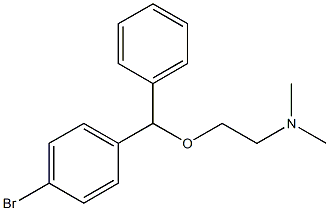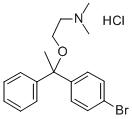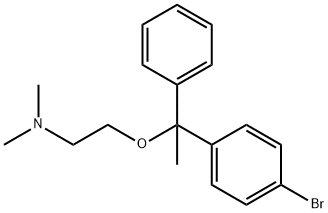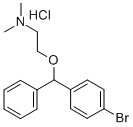N-2-(4-bromobenzhydryloxy)ethyldimethylamine
- CAS NO.:118-23-0
- Empirical Formula: C17H20BrNO
- Molecular Weight: 334.25
- MDL number: MFCD00865688
- EINECS: 204-238-8
- SAFETY DATA SHEET (SDS)
- Update Date: 2024-11-19 23:02:33

What is N-2-(4-bromobenzhydryloxy)ethyldimethylamine?
Absorption
Well absorbed in the digestive tract.
Toxicity
Signs of overdose include wheezing, tightness in the chest, fever, itching, bad cough, blue skin color, fits, swelling of face, lips, tongue, or throat.
Originator
Bromazine,Shanghai Lansheng Corporation
The Uses of N-2-(4-bromobenzhydryloxy)ethyldimethylamine
Antihistaminic.
Indications
For management of symptoms related to hay fever and other types of allergy and used to help bring up phlegm, thin secretions, and make a cough productive.
Background
Bromodiphenhydramine is an ethanolamine antihistamine with antimicrobial property. Bromodiphenhydramine is used in the control of cutaneous allergies. Ethanolamine antihistamines produce marked sedation in most patients.
Definition
ChEBI: A tertiary amino compound that is the 4-bromobenzhydryl ether of 2-(dimethylamino)ethanol. An antihistamine with antimicrobial properties, it is used in the control of cutaneous allergies.
Manufacturing Process
28.1 parts of p-bromobenzhydrylbromide are heated to boiling, under reflux
and with stirring, with 50 parts of ethylene chlorohydrin and 5.3 parts of
calcined sodium carbonate. The reaction product is extracted with ether and
the etheral solution washed with water and dilute hydrochloric acid. The
residue from the solution in ether [p-bromobenzhydryl(β-chloroethyl)ether].
28.1 parts of this ether are heated with 12 parts of dimethylethylamine in a
sealed tube for 4 hours at 110°C. The product of the reaction is extracted
several time with dilute hydrochloric acid. The acid solution made alkaline, in
the cold, with concentrated caustic soda solution, and the base which
separates taken up in ether. The ether extract is washed with concentrated
potassium carbonate solution, evaporated down, and the residue distilled in
vacuo. Boiling point of p-bromo-α-phenylbenzyloxy)-N,N-dimethylethylamine
151-154°C under 0.3 mm.
p-Bromo-α-phenylbenzyloxy)-N,N-dimethylethylamine may be used as a
hydrochloride.
brand name
Ambodryl.
Therapeutic Function
Antihistaminic
Pharmacokinetics
Bromodiphenhydramine is an antihistamine of the ethanolamine class. Ethanolamine antihistamines have significant antimuscarinic activity and produce marked sedation in most patients. In addition to the usual allergic symptoms, the drug also treats irritant cough and nausea, vomiting, and vertigo associated with motion sickness. It also is used commonly to treat drug-induced extrapyramidal symptoms as well as to treat mild cases of Parkinson's disease. Rather than preventing the release of histamine, as do cromolyn and nedocromil, Bromodiphenhydramine competes with free histamine for binding at HA-receptor sites. Bromodiphenhydramine competitively antagonizes the effects of histamine on HA-receptors in the GI tract, uterus, large blood vessels, and bronchial muscle. Ethanolamine derivatives have greater anticholinergic activity than do other antihistamines, which probably accounts for the antidyskinetic action of Bromodiphenhydramine. This anticholinergic action appears to be due to a central antimuscarinic effect, which also may be responsible for its antiemetic effects, although the exact mechanism is unknown.
Metabolism
Hepatic (cytochrome P-450 system); some renal.
Properties of N-2-(4-bromobenzhydryloxy)ethyldimethylamine
| Boiling point: | 151-154 °C(Press: 0.3 Torr) |
| Density | 1.259±0.06 g/cm3(Predicted) |
| pka | pKa 8.64(H2O
t = 25
c = 0.002 to 0.01) (Uncertain) |
Safety information for N-2-(4-bromobenzhydryloxy)ethyldimethylamine
Computed Descriptors for N-2-(4-bromobenzhydryloxy)ethyldimethylamine
New Products
Tert-butyl bis(2-chloroethyl)carbamate (S)-3-Aminobutanenitrile hydrochloride N-Boc-D-alaninol N-BOC-D/L-ALANINOL N-octanoyl benzotriazole 4-Hydrazinobenzoic acid 3,4-Dibenzyloxybenzaldehyde 1,1’-CARBONYLDIIMIDAZOLE R-2-BENZYLOXY PROPIONIC ACID 1,1’-CARBONYLDI (1,2-4 TRIAZOLE) 4-HYDROXY BENZYL ALCOHOL 3-NITRO-2-METHYL ANILINE (2-Hydroxyphenyl)acetonitrile 4-Bromopyrazole 5-BROMO-2CYANO PYRIDINE 5,6-Dimethoxyindanone 5-broMo-2-chloro-N-cyclopentylpyriMidin-4-aMine 4-methoxy-3,5-dinitropyridine 2-(Cyanocyclohexyl)acetic acid 2-aminopropyl benzoate hydrochloride 1-(4-(aminomethyl)benzyl)urea hydrochloride tert-butyl 4- (ureidomethyl)benzylcarbamate diethyl 2-(2-((tertbutoxycarbonyl)amino) ethyl)malonate Ethyl-2-chloro((4-methoxyphenyl)hydrazono)acetateRelated products of tetrahydrofuran







You may like
-
 873-83-6 6-Aminouracil (or) 4-Amino-2,6- dihydroxypyrimidine, (or) 6-Amino2,4-pyrimidinediol 99%View Details
873-83-6 6-Aminouracil (or) 4-Amino-2,6- dihydroxypyrimidine, (or) 6-Amino2,4-pyrimidinediol 99%View Details
873-83-6 -
 55441-95-7 99%View Details
55441-95-7 99%View Details
55441-95-7 -
 N-Vinylformamide 99%View Details
N-Vinylformamide 99%View Details
13162-05-5 -
 Chloro Uracil 1820-81-1 99%View Details
Chloro Uracil 1820-81-1 99%View Details
1820-81-1 -
 207557-35-5 99%View Details
207557-35-5 99%View Details
207557-35-5 -
 2-ethyl-6-methyl-3-hydroxypyridine succinate 99%View Details
2-ethyl-6-methyl-3-hydroxypyridine succinate 99%View Details
127464-43-1 -
 2-ETHYLPYRIDINE 100-71-0 99%View Details
2-ETHYLPYRIDINE 100-71-0 99%View Details
100-71-0 -
 181228-33-1 (S)-Methyl 3-amino-2-((tert-butoxycarbonyl)amino)propanote Hydrochloride (DAP-OMe. HCl) 99%View Details
181228-33-1 (S)-Methyl 3-amino-2-((tert-butoxycarbonyl)amino)propanote Hydrochloride (DAP-OMe. HCl) 99%View Details
181228-33-1